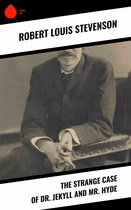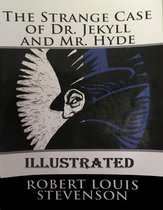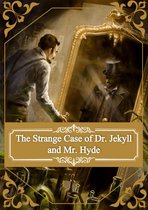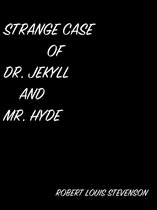The Strange Case of Dr. Jekyll and Mr. Hyde Ebook Tooltip Ebooks kunnen worden gelezen op uw computer en op daarvoor geschikte e-readers.
Afbeeldingen
Sla de afbeeldingen overArtikel vergelijken
- Engels
- E-book
- 1230003875810
- 07 mei 2020
- Epub zonder kopieerbeveiliging (DRM)
Robert Louis Stevenson
(Bron: Wikipedia. Beschikbaar onder de licentie Creative Commons Naamsvermelding/Gelijk delen.)"
Samenvatting
Strange Case of Dr Jekyll and Mr Hyde is a gothic novella by Scottish author Robert Louis Stevenson, first published in 1886. The work is also known as The Strange Case of Jekyll Hyde, Dr Jekyll and Mr Hyde, or simply Jekyll & Hyde. It is about a London legal practitioner named Gabriel John Utterson who investigates strange occurrences between his old friend, Dr Henry Jekyll, and the evil Edward Hyde. The novella's impact is such that it has become a part of the language, with the phrase "Jekyll and Hyde" entering the vernacular to refer to people with an unpredictably dual nature: outwardly good, but sometimes shockingly evil.
Stevenson had long been intrigued by the idea of how human personalities can affect how to incorporate the interplay of good and evil into a story. While still a teenager, he developed a script for a play about Deacon Brodie, which he later reworked with the help of W. E. Henley and which was produced for the first time in 1882. In early 1884, he wrote the short story "Markheim", which he revised in 1884 for publication in a Christmas annual. According to his essay, "A Chapter on Dreams" (Scribner's, Jan. 1888), he racked his brains for an idea for a story and had a dream, and upon wakening had the intuition for two or three scenes that would appear in the story Strange Case of Dr Jekyll and Mr. Hyde. Biographer Graham Balfour quoted Stevenson's wife Fanny Stevenson:
In the small hours of one morning, I was awakened by cries of horror from Louis. Thinking he had a nightmare, I awakened him. He said angrily: "Why did you wake me? I was dreaming a fine bogey tale." I had awakened him at the first transformation scene.
scene.
Lloyd Osbourne, Stevenson's stepson, wrote: "I don't believe that there was ever such a literary feat before as the writing of Dr Jekyll. I remember the first reading as though it were yesterday. Louis came downstairs in a fever; read nearly half the book aloud; and then, while we were still gasping, he was away again, and busy writing. I doubt if the first draft took so long as three days."
Inspiration may also have come from the writer's friendship with Edinburgh-based French teacher Eugene Chantrelle, who was convicted and executed for the murder of his wife in May 1878. Chantrelle, who had appeared to lead a normal life in the city, poisoned his wife with opium. According to author Jeremy Hodges, Stevenson was present throughout the trial and as "the evidence unfolded he found himself, like Dr Jekyll, 'aghast before the acts of Edward Hyde'." Moreover, it was believed that the teacher had committed other murders both in France and Britain by poisoning his victims at supper parties with a "favourite dish of toasted cheese and opium".
As was customary, Mrs. Stevenson would read the draft and offer her criticisms in the margins. Robert Stevenson was confined to bed at the time from a haemorrhage. Therefore, she left her comments with the manuscript and Robert in the toilet. She said that in effect the story was really an allegory, but Robert was writing it as a story. After a while, Robert called her back into the bedroom and pointed to a pile of ashes: he had burnt the manuscript in fear that he would try to salvage it, and in the process forced himself to start again from nothing, writing an allegorical story as she had suggested. Scholars debate whether he really burnt his manuscript; there is no direct factual evidence for the burning, but it remains an integral part of the history of the novella.
Stevenson re-wrote the story in three to six days. A number of later biographers have alleged that Stevenson was on drugs during the frantic re-write; for example, William Gray's revisionist history A Literary Life (2004) said he used cocaine while other biographers said he used ergot. However, the standard history, according to the accounts of his wife and son (and himself), says he was bed-ridden and sick while writing it. According to Osbourne, "The mere physical feat was tremendous and, instead of harming him, it roused and cheered him inexpressibly". He continued to refine the work for four to six weeks after the initial re-write. The novella was written in the southern English seaside town of Bournemouth, where Stevenson had moved due to ill health, to benefit from its sea air and warmer southern climate.
The name Jekyll was borrowed from Reverend Walter Jekyll, a friend of Stevenson and younger brother of horticulturalist and landscape designer Gertrude Jekyll.
Gabriel John Utterson and his cousin Richard Enfield reach the door of a large house on their weekly walk. Enfield tells Utterson that months ago he saw a sinister-looking man named Edward Hyde trample a young girl after accidentally bumping into her. Enfield forced Hyde to pay £100 to avoid a scandal. Hyde brought them to this door and provided a cheque signed by a reputable gentleman (later revealed to be Doctor Henry Jekyll, a friend and client of Utterson). Utterson is disturbed because Jekyll recently changed his will to make Hyde the sole beneficiary. Utterson fears that Hyde is blackmailing Jekyll. When Utterson tries to discuss Hyde with Jekyll, Jekyll tells Utterson he can be rid of Hyde when he wants and for Utterson to drop the matter.
One night in October, a servant sees Hyde beat Sir Danvers Carew, another one of Utterson's clients, to death. The police contact Utterson, who leads officers to Hyde's apartment. Hyde has vanished, but they find half of a broken cane (the other half having been left at the crime scene). Utterson recognizes the cane as one he had given to Jekyll. Utterson visits Jekyll, who shows Utterson a note, allegedly written to Jekyll by Hyde, apologising for the trouble that he has caused. However, Hyde's handwriting is similar to Jekyll's own, leading Utterson to conclude that Jekyll forged the note to protect Hyde.
For two months, Jekyll reverts to his former sociable manner, but in early January, he starts refusing visitors. Dr Hastie Lanyon, a mutual acquaintance of Jekyll and Utterson, dies of shock after receiving information relating to Jekyll. Before his death, Lanyon gives Utterson a letter to be opened after Jekyll's death or disappearance. In late February, during another walk with Enfield, Utterson starts a conversation with Jekyll at a window of his laboratory. Jekyll suddenly slams the window and disappears.
In early March, Jekyll's butler, Mr. Poole, visits Utterson and says Jekyll has secluded himself in his laboratory for weeks. Utterson and Poole break into the laboratory, where they find Hyde wearing Jekyll's clothes and apparently dead from suicide. They find a letter from Jekyll to Utterson. Utterson reads Lanyon's letter, then Jekyll's. Lanyon's letter reveals his deterioration resulted from the shock of seeing Hyde drink a serum that turned him into Jekyll. Jekyll's letter explains that he had indulged in unstated vices and feared discovery. He found a way to transform himself and thereby indulge his vices without fear of detection. Jekyll's transformed body, Hyde, was evil, self-indulgent, and uncaring to anyone but himself. Initially, Jekyll controlled the transformations with the serum, but one night in August, he became Hyde involuntarily in his sleep.
Jekyll resolved to cease becoming Hyde. One night, he had a moment of weakness and drank the serum. Hyde, his desires having been caged for so long, killed Carew. Horrified, Jekyll tried more adamantly to stop the transformations. Then, in early January, he transformed involuntarily while awake. Far from his laboratory and hunted by the police as a murderer, Hyde needed help to avoid capture. He wrote to Lanyon (in Jekyll's hand), asking his friend to bring chemicals from his laboratory. In Lanyon's presence, Hyde mixed the chemicals, drank the serum, and transformed into Jekyll. The shock of the sight instigated Lanyon's deterioration and death. Meanwhile, Jekyll's involuntary transformations increased in frequency and required ever larger doses of serum to reverse. It was one of these transformations that caused Jekyll to slam his window shut on Enfield and Utterson.
Eventually, one of the chemicals used in the serum ran low, and subsequent batches prepared from new stocks failed to work. Jekyll speculated that one of the original ingredients must have some unknown impurity that made it work. Realizing that he would stay transformed as Hyde, Jekyll decided to write his "confession". He ended the letter by writing this: "Here then, as I lay down the pen and proceed to seal up my confession, I bring the life of that unhappy Henry Jekyll to an end." With these words, both the document and the novella come to a close.
Source Wikipedia
Productspecificaties
Inhoud
- Taal
- en
- Bindwijze
- E-book
- Oorspronkelijke releasedatum
- 07 mei 2020
- Ebook Formaat
- Epub zonder kopieerbeveiliging (DRM)
Betrokkenen
- Hoofdauteur
- Robert Louis Stevenson
- Hoofduitgeverij
- Sanjiv Makkar
Lees mogelijkheden
- Lees dit ebook op
- Android (smartphone en tablet) | Kobo e-reader | Desktop (Mac en Windows) | iOS (smartphone en tablet) | Windows (smartphone en tablet)
Overige kenmerken
- Studieboek
- Nee
EAN
- EAN
- 1230003875810
Je vindt dit artikel in
- Categorieën
- Taal
- Engels
- Boek, ebook of luisterboek?
- Ebook
- Beschikbaar in Kobo Plus
- Beschikbaar in Kobo Plus
- Beschikbaarheid
- Leverbaar
Kies gewenste uitvoering
Prijsinformatie en bestellen
De prijs van dit product is 4 euro en 90 cent.- E-book is direct beschikbaar na aankoop
- E-books lezen is voordelig
- Dag en nacht klantenservice
- Veilig betalen
Rapporteer dit artikel
Je wilt melding doen van illegale inhoud over dit artikel:
- Ik wil melding doen als klant
- Ik wil melding doen als autoriteit of trusted flagger
- Ik wil melding doen als partner
- Ik wil melding doen als merkhouder
Geen klant, autoriteit, trusted flagger, merkhouder of partner? Gebruik dan onderstaande link om melding te doen.








